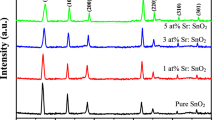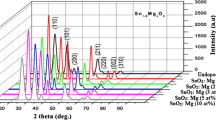Abstract
This paper discuss the structural, optical and electrical properties of aluminium doped tin oxide thin films prepared by sol-gel spin coating technique. The tetragonal rutile structure of SnO2 was confirmed from the XRD measurements and having a preferential orientation along (1 1 0) plane. FESEM analysis reveals that the particles were uniformly distributed in the film and they are in the range of 10.15–39.58 nm. UV-Vis spectroscopy studies shows that the films were highly transparent and the band gap values are ranging from 3.30 to 3.57 eV. FTIR study reveals that the prepared films contain Sn–O–Sn, Sn–O, H–O–H, C–O and Sn–OH vibrations. Hall measurement analysis shows that the conductivity type was reversed from n-type to p-type at higher doping concentration of aluminium. The calculated values of mean free path were ranging from 0.6052 to 5.3732 A0. The Figure Of Merit (FOM) values were calculated and are ranging from 5.58 × 10−7 Ω−1 to 1.74 × 10−5 Ω−1.

The conductivity type was changed from n-type to p-type by doping tin oxide with 15 wt% aluminium.
Highlights
-
XRD confirms the tetragonal rutile structure of SnO2 thin films.
-
FESEM shows the agglomerated network like structures for 10 wt% aluminium doped tin oxide.
-
The charge carrier concentration of the sample first decreases with increase in alumnium doping concentration up to 10 wt% aluminium doping and it decreases for 15 wt% aluminium doped tin oxide thin films.
-
Conductivity type was inverted from n-type to p-type at 15 wt% aluminium doping.














Similar content being viewed by others
References
Ezenwaka LN, Umeokwonna NS, Okoli NL (2019) Optical, structural, morphological, and compositional properties of cobalt doped tin oxide (CTO) thin films deposited by modified chemical bath method in alkaline medium. Ceram Int 19:1–18. https://doi.org/10.1016/j.ceramint.2019.11.106
Seng NK, Ahmad MK, Jasmin NS et al. (2016) Effect of annealing time on aluminium doped tin oxide (SnO2) as a transparent conductive oxide. ARPN J Eng Appl Sci 11:8915–8920
Razeghizadeh AR, Zalaghi L, Kazeminezhad I, Rafee V (2012) Growth and Optical Properties Investigation of Pure and Al- doped SnO2 Nanostructures by Sol-Gel Method. Afr Rev Phys 7(0028):1–9
M. Mwamburi MM (2012) The influence of Al doping on optical, electrical and structural properties of transparent and conducting SnO2: Al thin films prepared by spray pyrolysis technique. Chem Phys 53:11922–1197. https://doi.org/10.30799/jtfr.007.17010102. and
Vinodkumar R, Lethy KJ, Beena D et al. (2009) Effect of thermal annealing on the structural and optical properties of nanostructured zinc oxide thin films prepared by pulsed laser ablation. Sol Energy Mater Sol Cells 93:74–78. https://doi.org/10.1016/j.solmat.2008.04.014
I. Saadeddin A, B. Pecquenard A, J.P. Manaud A, R. Decourt ACLA, T. Buffeteau BGC (2007) Synthesis and characterization of single and co-doped SnO2 thin films for optoelectronic applications. Appl Surf Sci 253:5240–5249
Marikkannan M, Vishnukanthan V, Vijayshankar A et al. (2015) A novel synthesis of tin oxide thin films by the sol-gel process for optoelectronic applications. AIP Adv 027122:0–8. https://doi.org/10.1063/1.4909542
Hamed NKA (2016) Fabrication of cobalt doped tin oxide thin film for Dye sensitized solar cell using spray pyrolysis deposition method. ARPN J Eng Appl Sci 11:8846–8851
Mohamedkhair AK, Drmosh QA, Yamani ZH (2019) Silver Nanoparticle-Decorated Tin Oxide Thin Films: Synthesis, Characterization, and Hydrogen Gas Sensing. Front Mater 6:1–10. https://doi.org/10.3389/fmats.2019.00188
Bari RH, Patil SB, Bari AR (2014) Synthesis, Characterization and gas sensing performance of sol-gel prepared nanocrystalline SnO2 thin films. Int J Smart Sens Intel Syst 7:610–629
H. Köse AOA, HA (2012) Sol–Gel Synthesis of Nanostructured SnO2 Thin Film Anodes for Li-Ion Batteries. ACTA Phys Pol 121:227–229
Lee S, Kwon K, Kim K et al. (2019) Electrical,structural,optical and adhesive Characteristics of Aluminum-Doped Tin Oxide Thin Films for Transparent Flexible Thin-Film Transistor Applications. Mater (Basel) 12:1–9. https://doi.org/10.3390/ma12010137
Fernandes C, Santa A, Santos Â, et al (2018) A Sustainable Approach to Flexible Electronics with Zinc-Tin Oxide Thin-Film Transistors. 1800032:1–10. https://doi.org/10.1002/aelm.201800032
Tripathy SK, Rajeswari PV, Hota BP (2012) Synthesis of Tin Oxide Thin Film and Effect of Number of Coating on Transmittance and Film Thickness 1. Afr Rev Phys 7:265–268
Rechberger F, Städler R, Tervoort E, Niederberger M (2016) Strategies to improve the electrical conductivity of nanoparticle-based antimony-doped tin oxide aerogels. J Sol-Gel Sci Technol 80:660–666. https://doi.org/10.1007/s10971-016-4156-3
Lin H, Katayanagi Y, Kishi T (2018) A solution-processed tin dioxide fi lm applicable as a transparent and fl exible humidity sensor. RSC Adv 8:30310–30319. https://doi.org/10.1039/C8RA04355H
Duraia ESM, Das S, Beall GW (2019) Humic acid nanosheets decorated by tin oxide nanoparticles and there humidity sensing behavior. Sens Actuators, B Chem 280:210–218. https://doi.org/10.1016/j.snb.2018.10.054
Sivasenthil E, Senthilkumar V (2016) Electrical Characterization of Tin Oxide Thinfilms prepared by Dip coating technique. IJIRSET 5:14651–14655. https://doi.org/10.15680/IJIRSET.2016.0508076
Aswathy BR, Vinay K, Arjun M, Manoj PK (2019) Deposition of tin oxide thin film by sol-gel dip coating technique and its characterization. AIP Conf Proc 2162:1–6. https://doi.org/10.1063/1.5130344
Adjimi A, Zeggar ML, Attaf N et al. (2018) Fluorine-Doped Tin Oxide Thin Films Deposition by Sol-Gel Technique. J Cryst Process Technol 8:89–106. https://doi.org/10.4236/jcpt.2018.84006
Tuyen LTC, Jian SR, Tien NT, Le PH (2019) Nanomechanical and material properties of fluorine-doped tin oxide thin films prepared by ultrasonic spray pyrolysis: effects of F-doping. Materials (Basel)1–12: https://doi.org/10.3390/ma12101665
Satyanarayana T, Reddy SS (2018) Study on Synthesis methods of Cobalt Doped Tin Oxide (SnO 2) Nanostructures. Sreyas Int J Sci Technocr 2:1–4
Doyan A, Susilawati IYD (2017) Synthesis and characterization of SnO2 thin layer with a doping aluminum is deposited on quartz substrates. AIP Conf Proc 1801:1–8. https://doi.org/10.1063/1.4973083
Kethzy Agnes J, Sharmila DJ, Praveen B et al. (2019) A featural analysis of aluminium doped SnO2 and Bare SnO2 thin films grown on FTO substrates. Mater Today Proc 8:207–213. https://doi.org/10.1016/j.matpr.2019.02.102
Gokcen Gokceli KN (2021) Investigation of hydrogen post-treatment effect on surface and optoelectronic properties of indium tin oxide thin fi lms € kçen G o. J Alloy Compd 851:1–7. https://doi.org/10.1016/j.jallcom.2020.156861
Jayakrishnan R (2015) Aluminum Doped ZnO Thin Films Using Chemical Spray Pyrolysis. OALib 02:1–10. https://doi.org/10.4236/oalib.1102108
Chandra S, George G, Ravichandran K, Thirumurugan K (2017) Influence of simultaneous cationic (Mn) and anionic (F) doping on the magnetic and certain other properties of SnO2 thin films. Surf Interfac. 7:39–46. https://doi.org/10.1016/j.surfin.2017.02.008
Shaban M, Attia GF, Basyooni MA, Hamdy H (2015) Morphological and Structural Properties of spin coated Tin Oxide thin films. Int J Eng Adv Res Technol 1:11–14
Saji SK, Vinodkumar R, Eappen SM, Wariar PRS (2017) Optical and dielectric characterization of gadolinium aluminate ceramic nanoparticles synthesized by combustion technique. Mater Chem Phys 193:189–195. https://doi.org/10.1016/j.matchemphys.2017.02.024
Majumder S (2009) Synthesis and characterisation of SnO 2 films obtained by a wet chemical process. Sci Mater 27:123–128
Vinodkumar R, Lethy KJ, Arunkumar PR, Renju NV, Pillai VPM, Pillai R (2010) Effect of cadmium oxide incorporation on the microstructural and optical properties of pulsed laser deposited nano structured zinc oxide thin films. Mater Chem Phys 121:406–413
Prabhu YT, Rao KV (2014) X-Ray Analysis by Williamson-Hall and Size-Strain Plot Methods of ZnO Nanoparticles with Fuel Variation. World J Nano Sci Eng 4:21–28
Vinodkumar R, Navas I, Chalana SR et al. (2010) Highly conductive and transparent laser ablated nanostructured Al: ZnO thin films. Appl Surf Sci 257:708–716. https://doi.org/10.1016/j.apsusc.2010.07.044
Ahmed SF, Ghosh SKPK, Chattopadhyay KK (2006) Effect of Al doping on the conductivity type inversion and electro-optical properties of SnO 2 thin films synthesized by sol-gel technique. J Sol-Gel Sci Technol 39:241–247. https://doi.org/10.1007/s10971-006-7808-x
Duan L, Zhang X, Yue K et al. (2017) Synthesis and Electrochemical Property of LiMn2O4 Porous Hollow Nanofiber as Cathode for Lithium-Ion Batteries. Nanoscale Res Lett 12:2–9. https://doi.org/10.1186/s11671-017-1879-1
Gowtham M, Logababu P (2018) The structural, Morphological and optical properties of tin oxide thin films prepared by spin coating method. Int J pure Appl Math 120:1555–1562
Manikandan SSE (2019) Enhanced structural, optical, electrochemical and magnetic behavior on manganese doped tin oxide nanoparticles via chemical precipitation method. J Mater Sci Mater Electron 1–12. https://doi.org/10.1007/s10854-019-01076-8
Samsonenko M, Zakutevskyy O, Khalameida S, Charmas B (2019) Influence of mechanochemical and microwave modification on ion- exchange properties of tin dioxide with respect to uranyl ions. Adsorption 25:451–457. https://doi.org/10.1007/s10450-019-00036-2
Santos LRB, Chartier T, Pagnoux C, Baumard JF, Santillii CV, Pulcinelli SH, AL A (2004) Tin oxide nanoparticle formation using a surface modifying agent Tin oxide nanoparticles formation using a surface modifying agent. J Eur Ceram Soc 1–9. https://doi.org/10.1016/j.jeurceramsoc.2004.03.003
Sapna D, Ponja A, Benjamin AD, Williamson AB, Sanjayan Sathasivam A, David O, Scanlon ABC, IPP A and CJC (2018) Enhanced electrical properties of antimony doped tin oxide thin films deposited via aerosol assisted chemical vapour deposition †. J Mater Chem C 6:7257–7266. https://doi.org/10.1039/c8tc01929k
Deyu GK, Muñoz-Rojas D, Rapenne L et al. (2019) SnO2 Films Deposited by Ultrasonic Spray Pyrolysis: influence of Al Incorporation on the Properties. Molecules 24:1–16. https://doi.org/10.3390/molecules24152797
Bhat JS, Maddani KI, Karguppikar AM, Ganesh S (2007) Electron beam radiation effects on electrical and optical properties of pure and aluminum doped tin oxide films. Nucl Instrum Methods Phys Res B 258:369–374. https://doi.org/10.1016/j.nimb.2007.02.074
Dang HP, Luc QH, Le T, Le VH (2016) The Optimum Fabrication Condition of p-Type Antimony Tin Oxide Thin Films Prepared by DC Magnetron Sputtering. J Nanomater 2016:1–11
Babar AR, Shinde SS, Moholkar AV et al. (2010) Structural and optoelectronic properties of antimony incorporated tin oxide thin films. J Alloy Compd 505:416–422. https://doi.org/10.1016/j.jallcom.2010.06.091
Wang JT, Shi XL, Liu WW et al. (2015) Influence of Preferred Orientation on the Electrical Conductivity of Fluorine-Doped Tin Oxide Films. Sci Rep 4:1–9. https://doi.org/10.1038/srep03679
Yildirim MA, Yildirim ST, Sakar EF, Ateş A (2014) Synthesis, characterization and dielectric properties of SnO2 thin films. Spectrochim Acta - Part A Mol Biomol Spectrosc 133:60–65. https://doi.org/10.1016/j.saa.2014.05.035
Shanthi S, Subramanian C, Ramasamy P (1999) Growth and characterization of antimony doped tin oxide thin films. J Cryst Growth 197:858–864
Babar AR, Shinde SS, Moholkar AV et al. (2011) Physical properties of sprayed antimony doped tin oxide thin films: the role of thickness. J Semicond 32:1–8. https://doi.org/10.1088/1674-4926/32/5/053001
Kim BH, Staller CM, Cho SH et al. (2018) High Mobility in Nanocrystal-Based Transparent Conducting Oxide Thin Films. ACS Nano 12:3200–3208. https://doi.org/10.1021/acsnano.7b06783
Kulkarni AK, Schulz KH, Lim TS, Khan M (1999) Dependence of the sheet resistance of indium-tin-oxide thin films on grain size and grain orientation determined from X-ray diffraction techniques. Thin Solid Films 345:273–277. https://doi.org/10.1016/S0040-6090(98)01430-8
Keskenler EF, Guven Turgut SA, Seydi Dogan BD (2013) The effect of fluorine and tungsten co-doping on optical, electrical and structural properties of tin (IV) oxide thin films prepared by sol – gel spin coating method. Opt Appl XLIII:663–677. https://doi.org/10.5277/oa130404
Cisneros-Contreras IR, Muñoz-Rosas AR-G AL (2019) Resolution improvement in Haacke’ s fi gure of merit for transparent conductive fi lms. Results Phys 15:102695. https://doi.org/10.1016/j.rinp.2019.102695
Pekker Á, Kamarás K (2010) A general figure of merit for thick and thin transparent conductive carbon nanotube coatings. J Appl Phys 108:1–7. https://doi.org/10.1063/1.3476278
Yu S, Li L, Lyu X, Zhang W (2016) Preparation and investigation of nano-thick FTO/Ag/FTO multilayer transparent electrodes with high figure of merit. Sci Rep 6:1–8. https://doi.org/10.1038/srep20399
Ramarajan R, Kovendhan M, Thangaraju K et al. (2020) Enhanced optical transparency and electrical conductivity of Ba and Sb co-doped SnO 2 thin fi lms. J Alloy Compd 823:1–11. https://doi.org/10.1016/j.jallcom.2020.153709
Acknowledgements
Authors acknowledge RUSA for providing spin coating unit and UV-Visible spectrophotometer.
Author information
Authors and Affiliations
Corresponding author
Ethics declarations
Conflict of interest
The authors declare no competing interests.
Additional information
Publisher’s note Springer Nature remains neutral with regard to jurisdictional claims in published maps and institutional affiliations.
Rights and permissions
About this article
Cite this article
Soumya, S.S., Vinodkumar, R. & Unnikrishnan, N.V. Conductivity type inversion and optical properties of aluminium doped SnO2 thin films prepared by sol-gel spin coating technique. J Sol-Gel Sci Technol 99, 636–649 (2021). https://doi.org/10.1007/s10971-021-05599-7
Received:
Accepted:
Published:
Issue Date:
DOI: https://doi.org/10.1007/s10971-021-05599-7




